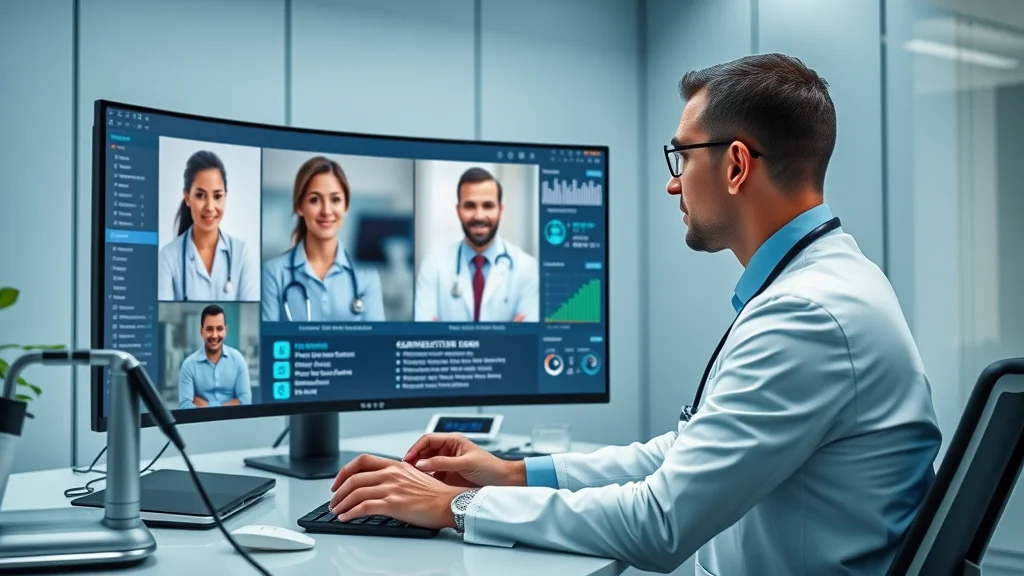Did you know? According to the American Medical Association, over 60% of U.S. physicians adopted telemedicine practices in 2023—nearly double the pre-pandemic rate. This unprecedented surge means virtual care isn’t just a convenience; it’s rapidly becoming the cornerstone of modern health care delivery. In this comprehensive guide, we’ll pull back the curtain on telemedicine—showing you exactly how it works, its game-changing benefits, and why this digital health revolution could mean you never go back to the old way of doing things.
Revolutionizing Health Care: Telemedicine at a Glance
Telemedicine is transforming the health care landscape, allowing patients and care providers to connect like never before. Instead of facing long waits or unnecessary travel for primary care or even complex specialties, anyone with an internet connection can access a board-certified doctor online. Services range from instant urgent care consultations to ongoing management of chronic conditions, bringing the future of health services to your fingertips.
This digital revolution provides real solutions for those who struggle to reach brick-and-mortar clinics—rural residents, busy professionals, caregivers, and even those with mobility issues. As more providers integrate robust telemedicine platforms, it’s never been easier to get high-quality virtual care. You’re about to discover exactly how telemedicine services deliver speed, efficiency, safety, and confidence in medical care—no matter where you are in the United States.

What You'll Learn About Telemedicine
- Core concepts and benefits of telemedicine.
- How telemedicine services function in today's health care landscape.
- Types of telemedicine service and their primary applications.
- Challenges, opportunities, and future outlook for virtual care and digital health services.
Understanding Telemedicine: Definition and Core Benefits
What is Telemedicine? How Does it Work?
Telemedicine is the remote provision of health care using digital communication tools. Through secure mobile apps or web platforms, patients can consult with health care professionals, discuss symptoms, receive diagnoses, and even get prescriptions—all from their own homes. The process usually starts with scheduling a video visit or phone call, entering basic health information, and connecting with a care provider who can review your case and recommend next steps.
Unlike traditional visits, telemedicine leverages technology like high-definition video, online chat, secure document uploads, and even real-time sharing of health metrics (such as blood pressure readings). This allows for efficient collaboration between patients, primary care doctors, and specialists, ensuring quicker access to medical services and tailored health care plans. In many cases, it streamlines lab tests ordering or medication management, integrating seamlessly with eHealth services around the world.
Comparing Telemedicine to Traditional Health Service
Traditional health services often require multiple steps—finding transportation, waiting in crowded clinics, and sometimes delayed follow-up. Telemedicine services break these barriers by delivering instant, secure, and personalized care. For routine checkups, chronic care management, or even mental health counseling, a virtual appointment can be just as effective as in-person care.
While certain emergencies and procedures still demand on-site attention, a growing body of research proves that for many needs (especially those involving remote patient monitoring), telemedicine can improve outcomes, lower costs, and boost patient satisfaction. With features like easy access to your health information and digital reminders, virtual care empowers patients to take charge of their health between visits, making it a natural evolution for modern health care.
Types of Telemedicine Service: Exploring the Options
Three Major Types of Telemedicine
- Real-time interactive virtual care (live video consultations with care providers)
- Remote patient monitoring (tracking health metrics like blood pressure)
- Store-and-forward (securely sharing health data and images)

Primary Care and Beyond: Telemedicine for Every Health Service
Initially, telemedicine found its roots in primary care—offering virtual checkups and quick advice for minor illnesses. Today, its reach extends far beyond—covering specialized health services like dermatology (store-and-forward for sharing skin images), remote heart or blood pressure monitoring for chronic condition management, and even virtual group therapy for mental health.
Dental consultations, nutritional counseling, physical therapy, and women’s health are all adopting virtual elements, helping patients get expert advice without ever leaving home. Comprehensive telemedicine platforms often coordinate with local clinics for lab tests or follow-ups, ensuring a seamless blend of digital and physical care for every health need.
How Telemedicine Works: Processes and Technology
Setting Up: What You Need for Telemedicine
- Secure telemedicine platforms and required technology
- Understanding patient registration and privacy policies
The first step to accessing virtual care is ensuring you have the right technology: a smartphone, tablet, or computer with a camera and microphone, plus a stable internet connection. Most major telemedicine services operate through user-friendly apps or secure web portals meeting strict privacy requirements, such as HIPAA compliance in the United States.
Before your first appointment, you'll need to register as a patient, provide basic health information, consent to privacy policies, and—if needed—coordinate with your insurance provider. All data shared through these platforms is encrypted, keeping your health information secure as you communicate with certified care professionals.
Step-by-Step: Your Virtual Care Visit
- Scheduling a virtual care appointment
- Connecting with your care provider online
- What to expect during a telemedicine consultation
Begin by logging in to your provider’s telemedicine service platform, selecting an available time slot, and confirming your choice. At your scheduled time, you’ll receive a secure video link or app notification, then enter a digital waiting room. When your care provider joins, you’ll discuss your symptoms, ask questions, and receive guidance—just like an in-person visit.
After the consultation, your provider may send electronic prescriptions, recommend lab tests or imaging, and set up future telemedicine visits. Most platforms let you message your doctor, access educational resources, and track your ongoing health metrics, making it easy to stay connected and proactive about your care services.
Take a dynamic, family-friendly tour: See how to create a telemedicine account, schedule appointments, experience the digital waiting room, and interact with your provider via video call—with smooth transitions and easy-to-understand visual cues.
Benefits of Telemedicine for Patients and Care Providers
Convenience and Accessibility of Telemedicine Services
The power of telemedicine is best seen in the comfort it brings to patients and flexibility it offers care teams. Whether managing a chronic illness or seeking urgent advice, you can skip traffic, avoid crowded waiting areas, and consult highly-qualified healthcare professionals from the sanctuary of your own home. Watchful parents, busy professionals, college students, and even caregivers supporting a family member are all discovering new peace of mind via virtual visits.
Telemedicine services are particularly transformative for rural populations, seniors, or those with limited transportation. For example, recent studies show that rural patients using virtual care are able to reduce hospital trips, receive more timely interventions, and better stay on top of ongoing blood pressure or diabetes management programs. In fact, the reduction in missed appointments means better health outcomes and saved resources for patients and providers alike.

Improving Health Services: Expert Quotes on Telemedicine
"Telemedicine has the potential to revolutionize care delivery by enabling timely access to medical expertise, regardless of patient location." — Dr. Sunil Patel, Telehealth Specialist
As Dr. Patel notes, this rapid access to expertise can mean the difference between early intervention and prolonged suffering, especially for those in medically underserved areas. The collaborative nature of virtual care also empowers care professionals to share insights and consult on unique or complex cases, ensuring every patient receives the best available guidance from the full spectrum of medical service resources.
Telemedicine Case Studies and Real-World Examples
What is an Example of Telemedicine?
Consider Emily, a working mom juggling a busy household and her own health needs. When she started noticing symptoms of hypertension, she turned to a telemedicine service offered by her health provider. After uploading blood pressure readings from her home monitor, she connected with her primary care physician over video.
Her doctor reviewed her results, adjusted her medication, and coordinated monthly remote check-ins—without Emily needing to leave her neighborhood. The support extended to dietary advice from a tele-nutritionist and streamlined lab tests at a nearby pharmacy. This seamless blend of virtual and in-person elements allowed her to manage her chronic condition efficiently and confidently.

Watch real stories: Patients reveal how virtual doctor visits, home health monitoring, and online mental health counseling have reshaped their health journeys. Hear directly from users about the convenience and reassurance telemedicine brings to their daily lives.
Telemedicine and Health Service Accessibility in the United States
Expanding Access to Health Services
The United States faces significant disparities in health care access—especially in remote or underserved regions. Telemedicine stands out as a practical solution, connecting patients with health services that once seemed out of reach. Clinical studies consistently highlight reduced no-show rates, faster access to medical care, and increased patient engagement—all thanks to the flexibility of virtual care and digital health innovation.
In recent years, healthcare networks have expanded telehealth offerings for everything from primary care to chronic disease management and mental health support, helping close critical care gaps across the country. National surveys show more adults—especially the elderly and those in under-resourced regions—are accessing care services virtually, reflecting telemedicine’s pivotal role in public health strategy.
Overcoming Barriers to Telemedicine Service
- Technology gaps
- Insurance coverage
- Regulatory considerations
Despite its promise, telemedicine faces real challenges. Technology gaps—such as lack of broadband internet or digital know-how—can limit who benefits. Insurance coverage, while expanding, still varies widely between states, employers, and specific telemedicine services. Regulatory hurdles also play a part, from licensure for care providers to privacy protection standards for health information.
Addressing these barriers requires sustained investment in digital infrastructure, clarity in health policies, and public-private partnerships to ensure every patient and care professional can participate fully in the virtual health revolution. With each step forward, more Americans gain access to timely, affordable, and high-quality care no matter their zip code.
| Platform Name | Key Features | Coverage (U.S. States) | Patient Cost | Specialties Offered |
|---|---|---|---|---|
| LiveCare | 24/7 video visits, mobile app, remote monitoring | 50 | $0–$75/visit (with insurance) | Primary care, mental health, urgent care |
| VirtualClinicPlus | Prescription delivery, e-labs, care team chat | 48 | $40–$90/visit | Primary care, specialists, physical therapy |
| eHealthConnect | AI triage, multilingual support, chronic care plans | All 50 | Varies by plan | Chronic disease, nutrition, pediatrics |
Addressing Concerns: Privacy, Security, and Quality of Care in Telemedicine
How Are My Health Services Protected Online?
- Encryption and data protection measures
- HIPAA compliance in the United States
When it comes to your digital health journey, security is non-negotiable. All reputable telemedicine services rely on rigorous encryption and software safeguards to keep your private medical data locked down during every telemedicine visit. In the United States, these platforms must meet HIPAA (Health Insurance Portability and Accountability Act) standards, so your health information remains confidential and protected from unauthorized access.
Look for services that clearly explain their privacy policies and data retention practices. Many also employ biometric authentication and advanced account verification for heightened security. By choosing a top-tier, compliant platform, you can confidently share health updates, symptom logs, and test results, trusting that your digital care is as safe as on-site clinical interactions.

Maintaining Quality in Digital Health Care
Patients and healthcare professionals alike often wonder: Is virtual care as thorough as a face-to-face visit? The answer, backed by extensive research, is a resounding yes for most routine and chronic care needs. Rigorous protocols, credentialed care providers, and robust documentation standards guarantee that digital consultations meet or exceed traditional health care quality benchmarks.
Many leading telemedicine services continuously monitor patient feedback, conduct peer reviews, and offer ongoing training for their clinicians. These best practices, combined with built-in quality checks and medical risk assessments, assure that you’re receiving evidence-based recommendations and safe, trusted care at every virtual touchpoint.
Telemedicine and Chronic Condition Management
Managing Chronic Conditions with Telemedicine Services
For millions living with chronic diseases—like hypertension, diabetes, or asthma—regular monitoring and timely interventions are crucial. Telemedicine services shine when it comes to remote patient management. With tools for home reporting of blood pressure or blood glucose, patients and doctors can spot trends early, adjust medications, and avoid costly ER visits.
Virtual care teams may include nurses, pharmacists, educators, and specialists who collaborate seamlessly to keep your health on track. The ability to update your provider in real-time means better adherence to treatment plans, personalized adjustments, and less stress for patients juggling family and work responsibilities.
Mental Health and Telemedicine Service Expansion
The stigma and logistical barriers around mental health used to make it hard for many people to seek help. Now, telemedicine services have dramatically lowered the bar to high-quality counseling, psychiatric care, and behavioral support. Patients can schedule video sessions with licensed therapists, access cognitive behavioral therapy modules, and get medication management—all without stepping outside their homes.
As demand for mental health care grows, so does the range of online providers, from one-on-one therapy to group sessions and crisis intervention support. Early data confirms that virtual counseling is just as effective as in-person care for most patients—and, for some, even more comfortable and accessible.

Future of Telemedicine: Trends and Opportunities
What’s Next in Virtual Care and Telemedicine?
- Artificial intelligence in telemedicine services
- Mobile health technology
- Consumer-driven health innovation
The future of telemedicine promises even greater personalization and reach. Artificial intelligence is already being deployed for symptom triage, treatment recommendations, and early warning systems in patient monitoring. The integration of wearables—like smartwatches or continuous glucose monitors—feeds health data directly to care providers, ensuring proactive, data-driven interventions.
Meanwhile, consumer-driven innovations in mobile apps, virtual reality rehabilitation, remote diagnostics, and chronic care coordination are empowering patients to take unprecedented control over their health and wellness journey. With these advancements, the next decade will likely see even more seamless, immersive, and accessible digital care for everyone.
Expert Perspective: Telemedicine in the Coming Decade
"The integration of AI and wearable technology will further personalize and expand telemedicine, making high quality health care accessible to all." — Dr. Emily Lin, Digital Health Innovator
As predicted by digital health visionaries like Dr. Lin, telemedicine’s growth will create smarter, safer, and far-reaching health solutions. New partnerships, regulations, and public trust will keep pushing this innovation to ensure no patient is left behind in the digital health revolution.
People Also Ask: Common Telemedicine Questions
What is telemedicine and how does it work?
Telemedicine uses secure digital communications—like video calls, messaging apps, and online portals—to connect patients and care providers remotely. You can schedule appointments, discuss symptoms, share test results, and receive prescriptions from home. Most platforms use advanced encryption and privacy protocols, providing safe, effective medical advice without requiring an in-person visit.
What is an example of telemedicine?
A common example is a patient consulting their primary care doctor over a video visit to discuss ongoing allergies. The doctor may review shared symptom logs, adjust prescriptions, and order lab tests for follow-up—all conducted online. Other examples include virtual therapy sessions, remote monitoring of chronic diseases, or dermatology assessments using uploaded smartphone photos.
Can I talk to a doctor online for free?
Some employers or health plans in the United States offer limited free telemedicine services as a benefit. Additionally, health departments may provide no-cost virtual care during public health emergencies. However, many telemedicine visits still require either a copay or direct payment, typically lower than traditional clinic fees.
What are the three types of telemedicine?
The three major types of telemedicine are: 1) Real-time interactive care (live video consultations), 2) Remote patient monitoring (using devices to track health stats and send them to providers), and 3) Store-and-forward (securely sharing images or health data with specialists for later review).
Frequently Asked Questions on Telemedicine
-
How do I choose a telemedicine provider?
Look for licensed platforms with board-certified clinicians, transparent privacy practices, and positive patient feedback. Check if your insurance covers the service for added savings. -
Are prescriptions available via telemedicine?
Yes, most platforms allow providers to issue electronic prescriptions for common conditions, with pickup or delivery options at your preferred pharmacy. -
Is telemedicine covered by insurance in the United States?
Coverage is expanding. Medicare, Medicaid, and many private insurers pay for a wide range of virtual care, but details may vary by state and plan. -
What technology do I need for telemedicine services?
You’ll need an internet-enabled device (like a smartphone or computer) with camera/microphone, and access to a secure telemedicine platform—usually a mobile app or website.
Key Takeaways: The Transformative Impact of Telemedicine
- Telemedicine services offer convenient, patient-centered health care solutions.
- Virtual care bridges accessibility gaps and supports ongoing health monitoring.
- Continued evolution will expand telemedicine’s role in health care worldwide.
Ready to Experience the Magic of Telemedicine?
Take your first step: Sign up with a reputable telemedicine platform, schedule a virtual visit, and discover firsthand the future of health care—efficient, safe, and just a click away.
 Add Row
Add Row  Add
Add 




Write A Comment